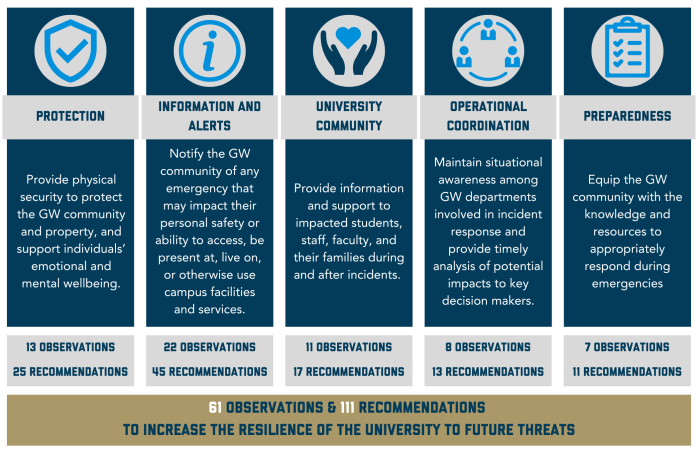On September 6, 2023, a homicide suspect escaped police custody at the George Washington University (GW) Hospital near GW’s Foggy Bottom campus. Given the potential risk to the GW community and in consultation with on-scene law enforcement, the university directed individuals on campus to shelter in place and restricted GWorld access to prevent individuals without GWorld cards from accessing campus spaces. University leadership and safety personnel coordinated closely with internal and external partners during the incident to provide updated safety guidance and direction through GW Alerts. Around 8 p.m., law enforcement reported that the suspect was no longer believed to be in the Foggy Bottom area, and the shelter in place direction ended 4 hours and 12 minutes after it was initiated. Following the all-clear, GWorld doors remained in locked mode until the next afternoon, allowing only the GW community to access campus spaces.
The next day, the university’s Office of Emergency Management began the after-action process to review the incident response and identify key strengths and areas for improvement. This process revealed several opportunities to enhance communication with the GW community and coordination across GW and with local partners. Over 150 faculty, staff, and students from 30 departments, offices, and schools across the university community provided feedback to inform the 111 recommendations included in this report. These observations and recommendations are organized into five key mission areas: Protection, Information and Alerts, University Community, Operational Coordination, and Preparedness. The university will continue to implement improvements based on the lessons learned throughout this process.
In the after-action process, GW community members were eager to provide feedback about the response and observed that the university maintained a safe operating environment during the incident. Many commended the university’s ability to remotely secure buildings and notify the community in a timely manner through GW Alerts. However, the GW community identified that GW Alert messaging was sometimes unclear, and the term “shelter in place" was ambiguous and subject to various interpretations. While some responded to the incident by barricading doors and remaining in classrooms into the evening, others continued to travel around campus as usual. Additionally, some questioned whether the shelter in place guidance was necessary, and many questioned how long the shelter in place lasted. Recognizing the potential impacts on the community, messaging during and following the incident provided guidance on mental health and other resources. Students, staff, and faculty praised this messaging, and the use of mental health resources following the incident remained consistent with pre-incident levels.
Across the GW community, stakeholders identified a desire for additional emergency preparedness training applicable to a wide range of emergencies. Many individuals reported they did not participate in emergency preparedness training in recent years. Faculty and staff frequently identified that they had not received adequate training on what shelter in place means, how to respond individually, or how to support students sheltering in place. Students often attributed school safety awareness to training received prior to attending GW and identified this as the cause of varying responses across the student population. Based on the observations detailed in this after-action report, the university identified the following immediate priorities to enhance campus resilience to future threats.
As a result, the university implemented enhancements in three areas, focusing on standardizing “protective actions,” or clear guidance that can be used when communicating in emergency situations.
Four protective actions will primarily be used moving forward in emergency situations—shelter, secure, lockdown and evacuate—with more specific information provided in follow-up communications based on the specific emergency. In addition, the university will rely on two GWorld modes—safety and emergency—to indicate, respectively, that building doors are accessible via tap access to GWorld cardholders or restricted to authorized emergency responders only.
The protective actions and GWorld modes can be used and communicated to the community in varying combinations depending on the emergency.



